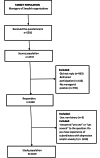Managers' attitudes to depression and the association with their rating of how work capacity is affected in employees with common mental disorders
- PMID: 38773610
- PMCID: PMC11110306
- DOI: 10.1186/s13104-024-06750-7
Managers' attitudes to depression and the association with their rating of how work capacity is affected in employees with common mental disorders
Abstract
Objective: This explorative, cross-sectional study assessed the association between managers' attitudes to employee depression and their rating of how common mental disorders (CMDs) affect employee work capacity.
Results: A principal component analysis was performed for the nine variables concerning managers' rating of how CMDs can affect work capacity among employees. The analysis resulted in two factors: task-oriented- and relational work capacity. The result of the multivariate analysis of covariance showed a p value of 0.014 (Pillai's trace) indicating a statistically significant association between managers' attitudes towards employee depression and managers' rating of how CMDs affect work capacity. The association was significant for both factors as indicated by the p value of 0.024 for task-oriented work capacity and the p value of 0.007 for relational work capacity. The R2 value was 0.022 for task-oriented work capacity and 0.017 for relational work capacity. We assumed that negative attitudes towards employee depression would be associated with a perception of decreased work capacity among employees with CMDs. The results showed a significant association; however, the effect (~ 2%) was small. Further studies of manager's attitudes and other possible determinants of managers' rating of CMD-related work capacity are needed to better understand these factors.
Keywords: Attitudes; Common mental disorder; Employee; Manager; Work capacity.
© 2024. The Author(s).
Conflict of interest statement
The authors declare that they have no competing interests.
Figures
Similar articles
-
Work accommodations for employees with common mental disorders and associated manager-related determinants: a cross-sectional study among Swedish managers.Disabil Rehabil. 2024 Sep;46(18):4256-4275. doi: 10.1080/09638288.2023.2269861. Epub 2023 Oct 22. Disabil Rehabil. 2024. PMID: 37865840
-
The significance of managers' knowledge of common mental disorders on managerial stigma towards employee depression: a cross-sectional study in Sweden.BMC Public Health. 2024 Feb 5;24(1):378. doi: 10.1186/s12889-023-17577-5. BMC Public Health. 2024. PMID: 38317109 Free PMC article.
-
How Managers Find Out About Common Mental Disorders Among Their Employees.J Occup Environ Med. 2021 Nov 1;63(11):975-984. doi: 10.1097/JOM.0000000000002287. J Occup Environ Med. 2021. PMID: 34091578
-
Managers' Support for Employee Wellness Programs: An Integrative Review.Am J Health Promot. 2018 Nov;32(8):1789-1799. doi: 10.1177/0890117118764856. Epub 2018 Apr 12. Am J Health Promot. 2018. PMID: 29649899 Review.
-
Effectiveness of training workplace managers to understand and support the mental health needs of employees: a systematic review and meta-analysis.Occup Environ Med. 2018 Jun;75(6):462-470. doi: 10.1136/oemed-2017-104789. Epub 2018 Mar 21. Occup Environ Med. 2018. PMID: 29563195
References
-
- Henshaw JL, Gaffney SH, Madl AK, Paustenbach DJ. The employer’s responsibility to maintain a safe and healthful work environment: an historical review of societal expectations and industrial practices. Empl Responsibilities Rights J. 2007;19:173–92. doi: 10.1007/s10672-007-9044-0. - DOI
-
- Martin A, Woods M, Dawkins S. How managers experience situations involving employee mental ill-health. Int J Workplace Health Manag. 2018;11:442–63. doi: 10.1108/IJWHM-09-2017-0069. - DOI
MeSH terms
LinkOut - more resources
Full Text Sources
Medical


